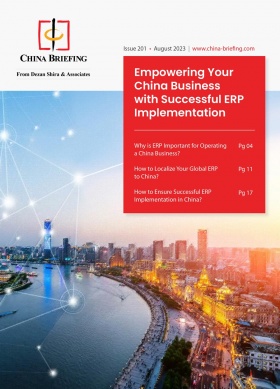China Monthly Tax Brief: October 2023
Expanded nationwide: Scope of issuers of fully digitalized e-fapiao in China
In October 2023, the local branches of the State Taxation Administration (STA) in seven provinces and cities, including Beijing, Hunan, Shandong, Anhui, Qinghai, Ningxia, and Guizhou, successively issued announcements on conducting the pilot program for fully digitalized electronic invoicing (hereinafter referred to as “fully digitalized e-fapiao”). According to these announcements, starting from November 1, 2023, these seven provinces and cities will carry out fully digitalized e-fapiao pilot programs among selected taxpayers. The specific scope will be determined by the respective tax authorities.
That is to say, as of November 1, 2023, all regions in the country, except Tibet, will allow pilot enterprises to issue fully digitalized e-fapiao through the e-invoicing service platform (e.g., Beijing). Previously, the scope of recipients of fully digitalized e-fapiao had been extended nationwide since August 28, 2022.
The pilot program of fully digitalized e-fapiao kicked off on December 1, 2021, when selected taxpayers in Shanghai, Guangdong (Guangzhou, Foshan, Guangdong-Macao Intensive Cooperation Zone), and Inner Mongolia (Hohhot) started to issue and accept fully digitalized e-fapiao.
In 2022 and 2023, the pilot program of fully digitalized e-fapiao kept expanding, with a broader scope of taxpayers being able to issue and accept fully digitalized e-fapiao. Fully digitalized e-fapiao gained popularity among taxpayers due to their advantages, such as no need for physical issuance, convenience, integrated information, and cost savings.
The fully digitalized e-fapiao implementation roadmap in the pilot regions is similar. Newly established enterprises or enterprises designated by the tax bureau are the initial adopters, with plans for subsequent expansion to all enterprises in the province or city.
For example, in Beijing, the tax bureaus in each district will select the first batch of pilot enterprises to start issuing fully digitalized e-fapiao in November and December. If the operation proceeds smoothly, it is expected that all Beijing enterprises will be able to use fully digitalized e-fapiao from January 2024.
There is no official statement at present regarding whether paper invoices and other electronic invoices will be immediately replaced after the implementation of fully digitalized e-fapiao.
Different Chinese cities may have different policies. Some cities have required taxpayers to cancel their paper invoices and other types of electronic invoices before adopting fully digitalized e-fapiao. On the other hand, cities like Beijing are implementing a dual-track system, which means paper invoices and other types of electronic invoices can be issued at the same time as fully digitalized e-fapiao. The duration of the dual-track system is not clear at present.
Convenience offered by fully digitalized e-fapiao
Fully digitalized e-fapiao are based on cloud technology and can achieve full digitalization of information. Meanwhile, fully digitalized e-fapiao requires only an internet connection for issuance.
In addition, fully digitalized e-fapiao also have the following advantages:
- No initial invoice approval required: Invoices can be issued as soon as the company is established.
- No need to apply for invoice quotas: The tax authorities will determine the initial maximum amount of invoices issued by the taxpayer in a calendar month and make dynamic adjustments thereto—based on the risk level, taxpaying credit rating, actual operating conditions, and other factors of a taxpayer. The term “maximum invoice amount” pertains to the highest permissible total invoice value that a pilot taxpayer can issue within a calendar month, excluding value-added tax (VAT). It is possible to manually modify the maximum invoice amount.
- No single invoice amount limit and no limit on the number of invoices issued each month: In contrast to traditional paper fapiao, fully digitalized e-fapiao is unrestricted by the quantity of fapiao documents or the maximum value of an individual fapiao.
- Simplified invoice information: Issuing fully digitalized e-fapiao only requires the company name and taxpayer’s registration number.
- No need for physical delivery: Invoice data files are automatically sent in real-time to the recipient’s tax digital account and can also be sent using QR codes or by email.
- No need for invoice application: The invoice application will be handled automatically by the e-invoicing service platform.
Challenges posed by fully digitalized e-fapiao
As fully digitalized e-fapiao is being rolled out nationwide, traditional paper invoices and other forms of electronic invoices, such as the traditional general VAT e-fapiao and the special VAT e-fapiao, will gradually be replaced by fully digitalized e-fapiao. Simultaneously, as invoicing becomes electronic and tax management becomes digitized, companies will face the following challenges.
Invoice cross-check and verification
From the recipient’s standpoint, a fully digitalized e-fapiao can be automatically delivered to the recipient’s tax digital account, and only the company’s designated tax personnel will have the privilege to access this account for downloading purposes.
In such a scenario, when employees request expense reimbursements, is it necessary for them to furnish OFD or PDF versions of the invoice for internal expense procedures? If this is not a requirement, how can the tax personnel effectively cross-verify the invoices submitted by employees with those present in the tax digital account? For companies lacking integrated business, financial, and tax systems, manually cross-referencing and validating invoices, particularly for those with a high volume of monthly expense applications, can be quite challenging. Consequently, this may elevate the risk of non-compliance.
Invoice recording and archiving
From the issuer’s viewpoint, the e-invoicing service platform can make bulk invoice issuance. However, the official platform’s bulk invoicing function is very simple, which has many limitations and cannot satisfy businesses’ customization needs. For companies dealing with a high volume of invoices, they are still suggested to invest time and resources in developing an in-house bulk invoicing system or opt for a third-party service provider.
Furthermore, companies must address the requirements for recording and archiving invoices. Taxpayers are mandated to link issued invoices with revenue in the financial system and securely retain the XML version of fully digitalized e-fapiao as electronic accounting documents.
In the realm of electronic invoicing and digital tax management, many companies face the challenge of seamlessly integrating the e-invoicing service platform with their in-house bulk invoicing system and enterprise financial system. This integration is vital for achieving end-to-end digital data flow, ultimately enhancing operational efficiency and management capabilities. Typically, this process necessitates either the secondary development of existing systems or the adoption of systems already equipped with this functionality.
Fapiao management during the dual-track period of paper and electronic invoices
As the nationwide pilot program for fully digitalized e-fapiao is in progress, companies must establish distinct processes for collecting, verifying, and archiving invoices to ensure compliance until traditional paper invoices and other electronic invoices are completely phased out.
How can companies get prepared?
The widespread adoption of fully digitalized e-fapiao offers many conveniences to companies but also presents challenges.
For newly established foreign-invested enterprises in China, especially small ones, their daily invoice management and internal control processes tend to be relatively simple and vulnerable due to their limited staff and business scale. However, these companies are more susceptible to compliance risks when facing tax audits.
More often than not, the financial systems of these companies’ headquarters struggle to meet China’s financial and tax digital compliance requirements. Localizing these existing global systems to address tax compliance risks is an option; however, it is not only costly and time-consuming but also involves considerations for data security and other compliance.
Therefore, these companies can consider adopting commonly used domestic financial systems or seek assistance from professional organizations that offer integrated solutions for financial and tax digitization. This will help companies better address the challenges posed by fully digitalized e-fapiao, achieve tax compliance, and reduce risks.
Moreover, it is essential for companies to conduct self-assessments in key areas on a routine basis to ensure compliance. These areas include:
- Employee expense management: Review the authenticity and reasonableness of expense applications, ensuring that invoices are genuine, compliant, and promptly effective.
- Vendor payments: Audit the consistency of invoice flows, fund flows, and business flows in transactions, and retain other evidence for confirming the authenticity of transactions.
- Refund of input VAT credit: Analyze the reasons for the occurrence of excess input tax credits, ensuring timely recognition of VAT revenue and removal of VAT credits that are not eligible for deduction.
- Discrepancies in VAT revenue and corporate income tax revenue: Regularly compare and analyze the reasons for discrepancies and make timely adjustments.
Also read
- China Monthly Tax Brief: September 2023
- China Monthly Tax Brief: August 2023
- China Monthly Tax Brief: July 2023
- China Monthly Tax Brief: June 2023
About Us
China Briefing is written and produced by Dezan Shira & Associates. The practice assists foreign investors into China and has done so since 1992 through offices in Beijing, Tianjin, Dalian, Qingdao, Shanghai, Hangzhou, Ningbo, Suzhou, Guangzhou, Dongguan, Zhongshan, Shenzhen, and Hong Kong. Please contact the firm for assistance in China at china@dezshira.com.
Dezan Shira & Associates has offices in Vietnam, Indonesia, Singapore, United States, Germany, Italy, India, Dubai (UAE), and Russia, in addition to our trade research facilities along the Belt & Road Initiative. We also have partner firms assisting foreign investors in The Philippines, Malaysia, Thailand, Bangladesh.
- Previous Article Australian Prime Minster Albanese Visits China, Meets with Chinese President Xi Jinping
- Next Article China International Import Expo 2023 – Trade, Policy, and Business Opportunities

























